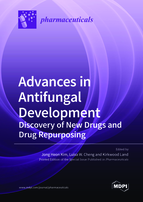Advances in Antifungal Development: Discovery of New Drugs and Drug Repurposing
A special issue of Pharmaceuticals (ISSN 1424-8247). This special issue belongs to the section "Medicinal Chemistry".
Deadline for manuscript submissions: closed (19 November 2021) | Viewed by 65222
Special Issue Editors
Interests: antifungal intervention; drug repurposing; drug resistance; redox adjuvants; resistance management
Special Issues, Collections and Topics in MDPI journals
Special Issues, Collections and Topics in MDPI journals
Interests: control of microbial growth; drug discovery; treatment for infectious diseases; animal pathogens
Special Issues, Collections and Topics in MDPI journals
Special Issue Information
Fungal infectious diseases such as aspergillosis, candidiasis or cryptococcus, etc., caused by yeast or filamentous fungal pathogens, are a persistent problem. Moreover, increased incidences of fungal resistance to a class of antifungal drugs make mycotic diseases a global human health concern. Higher infection rates by drug-resistant fungi have been determined in high-risk patients, especially in the immune-compromised groups of people who are vulnerable to various opportunistic and conventional fungal pathogens. However, current antifungal interventions have often exhibited limited efficacy in treating fungal infections, partly because the development of new antifungal drugs has become stagnant. Only three classes of antifungal drugs are used in clinical settings, namely, azoles, polyenes, and echinocandins; azoles and polyenes were introduced in 1980, while the echinocandin caspofungin was approved for the clinical uses after 2000. It is estimated that the overall duration and costs from lead discovery to regulatory approval of new antifungals takes more than 10 years and $300 million, respectively. Meanwhile, an alternative drug discovery strategy termed drug repurposing has been explored recently. Antifungal drug repurposing is the repositioning process of already marketed pharmaceutical drugs previously approved for curing human diseases such as cardiovascular diseases, arthritis, atherosclerosis, etc., to control fungal infections. One of the advantages of drug repurposing is that the mechanisms of action or safety of the drugs have been well-characterized.
This Special Issue will discuss recent advances in the field of antifungal drug discovery or repurposing with hopes of enhancing the efficiency of current antifungal interventions and identifying new antifungal drugs or alternatives.
Dr. Kirkwood Land
Dr. Jong Heon Kim
Dr. Luisa W. Cheng
Guest Editors
Manuscript Submission Information
Manuscripts should be submitted online at www.mdpi.com by registering and logging in to this website. Once you are registered, click here to go to the submission form. Manuscripts can be submitted until the deadline. All submissions that pass pre-check are peer-reviewed. Accepted papers will be published continuously in the journal (as soon as accepted) and will be listed together on the special issue website. Research articles, review articles as well as short communications are invited. For planned papers, a title and short abstract (about 100 words) can be sent to the Editorial Office for announcement on this website.
Submitted manuscripts should not have been published previously, nor be under consideration for publication elsewhere (except conference proceedings papers). All manuscripts are thoroughly refereed through a single-blind peer-review process. A guide for authors and other relevant information for submission of manuscripts is available on the Instructions for Authors page. Pharmaceuticals is an international peer-reviewed open access monthly journal published by MDPI.
Please visit the Instructions for Authors page before submitting a manuscript. The Article Processing Charge (APC) for publication in this open access journal is 2900 CHF (Swiss Francs). Submitted papers should be well formatted and use good English. Authors may use MDPI's English editing service prior to publication or during author revisions.
Keywords
- Antifungals
- Aspergillus
- Candida
- Cryptococcus
- Drug discovery
- Drug repurposing
- Drug targets
- Multidrug resistance
- Public health
- Stress signaling









